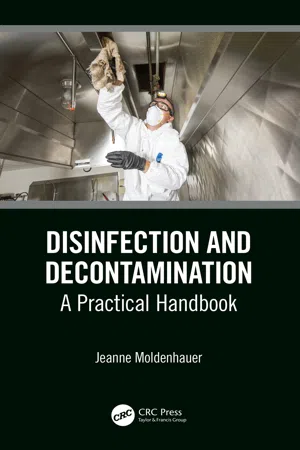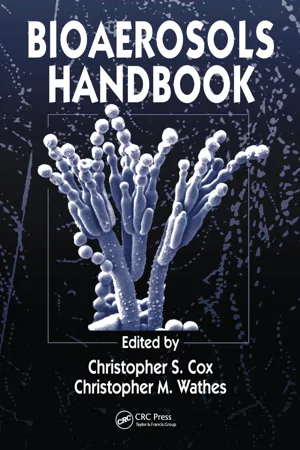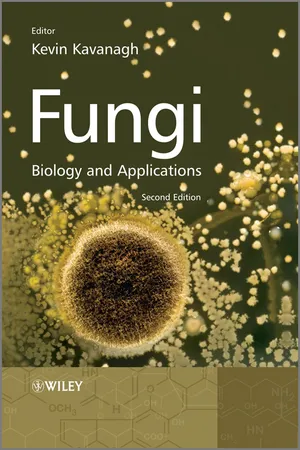Biological Sciences
Molds
Molds are a type of fungus that typically grows in the form of multicellular filaments called hyphae. They reproduce by forming spores, which can be dispersed through the air or water. Molds play important roles in nature, such as breaking down organic matter, but they can also cause health issues and damage to buildings when they grow indoors.
Written by Perlego with AI-assistance
3 Key excerpts on "Molds"
- eBook - ePub
Disinfection and Decontamination
A Practical Handbook
- Jeanne Moldenhauer(Author)
- 2018(Publication Date)
- CRC Press(Publisher)
. , 2011a).Fungi, which include the organisms that are called yeasts and Molds can have a very significant impact on human existence, e.g. (Moore et al. , 2011a):• The following would not be available without fungi: bread, alcohol, soft drinks, cheese, and coffee. • Fungi can secrete enzymes into their environment to digest nutrients externally to start biotech processes such as cheese production. • They aid in the digestion of grass eaten by cows. • They make plant roots work more effectively helping to grow corn, oats, potatoes, lettuce, cabbage, peas, celery, herbs, spices, cotton, flax, timber, and the like. • They aid in the production of oxygen for us to breathe. • They produce a variety of compounds used to make medications such as cholesterol-controlling drugs (statins) and some antibiotics, e.g., penicillins and agricultural fungicides. • They are even used in the distressing process of denim to manufacture stone-washed jeans. Unfortunately, fungi are not always good for us. They can be responsible for diseases of crops, human infections, and can produce harmful chemicals like mycotoxins that can impact pharmaceuticals. 11.2 Why Are Molds Important? Product recalls due to mold have had high visibility in the industry. Several recalls of products due to mold contamination occurred, including the following (Cundell, 2016):• Pharmaceutical tablet recalls in 2009 through 2011 due to the mold generated Tribromoanisole taints from wooden pallets. Lumber treated with Tribromophenol (TBP) in South America was used in the Caribbean. Due to the high humidity in Puerto Rico, mold growth occurred on the pallets. This in turn resulted in fungal methylation of TBP to the volatile, odorous taint tribromoanisole (TBA). Although users did not like the odor, it was not a toxicological concern. PDA Technical Report No. 55 (2017) was published regarding this topic. - eBook - ePub
- Christopher S. Cox, Christopher M. Wathes(Authors)
- 2020(Publication Date)
- CRC Press(Publisher)
14Biological Analysis of Fungi and Associated Molds
T.M. Madelin and M.F. Madelin
INTRODUCTION
General Characteristics of Fungi and Associated Molds
Spores and hyphal fragments of fungi are ubiquitous in air, where they are sometimes the major pollutant and sources of infection or allergic reactions. For the great majority of dry-spored fungi, air is their natural dispersal medium, and accordingly they have evolved various mechanisms that enhance their effective dispersal and survival in air. From the aerobiological standpoint this is an important difference from bacteria and viruses. Fungal spores vary greatly in size, but most are in the range 2–50 μm they are bigger than actinomycete and other bacterial spores and generally smaller than pollens (see Figures 14.1 and 14.2 ).Figure 14.1. Scanning electron photomicrograph of conidiophores of Penicillium cam-embertii bearing chains of spores (courtesy of Dr. A. Beckett, University of Bristol). Scale bar 20 //m.Figure 14.2. Airborne fungal spores released from disturbed straw, and trapped with May/RE Cascade Impactor. Scale bar 20 μAirborne fungal spores cannot rise or move laterally in air except through wind and turbulence (see Chapter 4 ). Consequently they must first traverse the boundary layer of still air that adjoins the surface from which they have originated in order to reach a region of air movement, for otherwise they would not disperse far from their site of formation. Their introduction into the turbulent region is commonly achieved by mechanisms or structures that shoot them through the boundary layer (such as bursting asci) or drop them from a height into moving air (such as the fruit bodies of bracket fungi and toadstools), or simply raise them on microscopic stalks the millimeter or so required to expose them to wind or gusts. The dispersal of fungal spores is treated comprehensively by Ingold.1 Not infrequently, fragments of mycelium and sporophores also become blown away. Some of these remain viable and capable of instituting new growth.2 - eBook - ePub
Fungi
Biology and Applications
- Kevin Kavanagh(Author)
- 2011(Publication Date)
- Wiley(Publisher)
In addition to the direct industrial exploitation of yeasts and fungi, it is important to note that these organisms, most notably the yeast Saccharomyces cerevisiae, play increasingly significant roles as model eukaryotic cells in furthering our fundamental knowledge of biological and biomedical science. This is especially the case now that numerous fungal genomes have been completely sequenced, and the information gleaned from fungal genomics and proteomics is providing valuable insight into human genetics and heritable disorders. However, knowledge of cell physiology is essential if the functions of many of the currently unknown fungal genes are to be fully elucidated. It is apparent, therefore, that fungi are important organisms for human society, health and well-being and that studies of fungal physiology are very pertinent to our understanding, control and exploitation of this group of microorganisms. This chapter describes some basic aspects of fungal cell physiology, focusing primarily on nutrition, growth and metabolism in unicellular yeasts and filamentous fungi. 1.2 Morphology of Yeasts and Fungi Most fungi are filamentous, many grow as unicellular yeasts and some primitive fungi, such as the chytridomycetes, grow as individual rounded cells or dichotomous branched chains of cells with root-like rhizoids for attachment to a nutrient resource. Here, we will consider the most common growth forms: the filamentous fungi and unicellular yeasts. 1.2.1 Filamentous Fungi The gross morphologies of macrofungi and microfungi are very diverse (see Plate 1.1). For example, we can easily recognize a variety of mushrooms and toadstools, the sexual fruiting bodies of certain macrofungi (the higher fungi Asomycotina and Basidiomycotina and related forms), during a walk through pasture or woodland
Index pages curate the most relevant extracts from our library of academic textbooks. They’ve been created using an in-house natural language model (NLM), each adding context and meaning to key research topics.
Explore more topic indexes
Explore more topic indexes
1 of 6
Explore more topic indexes
1 of 4


